

Earth Temperature Timeline. Tolstoy. Tolstoy’s What is Art?
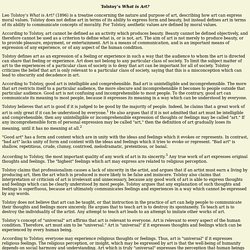
Leo Tolstoy’s What is Art? (1896) is a treatise concerning the nature and purpose of art, describing how art can express moral values. Tolstoy does not define art in terms of its ability to express form and beauty, but instead defines art in terms of its ability to communicate concepts of morality. For Tolstoy, aesthetic values are defined by moral values. According to Tolstoy, art cannot be defined as an activity which produces beauty. Tolstoy defines art as an expression of a feeling or experience in such a way that the audience to whom the art is directed can share that feeling or experience.
Corita Kent. Corita Kent (November 20, 1918 – September 18, 1986), aka Sister Mary Corita Kent, was born Frances Elizabeth Kent in Fort Dodge, Iowa.[1] Kent was an American Catholic nun, an artist, and an educator who worked in Los Angeles and Boston.
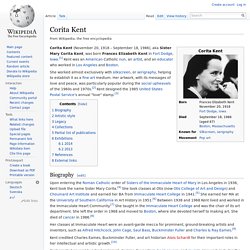
She worked almost exclusively with silkscreen, or serigraphy, helping to establish it as a fine art medium. Her artwork, with its messages of love and peace, was particularly popular during the social upheavals of the 1960s and 1970s.[2] Kent designed the 1985 United States Postal Service's annual "love" stamp.[3] Biography[edit] Minimalism. In the visual arts and music, minimalism is a style that uses pared-down design elements.
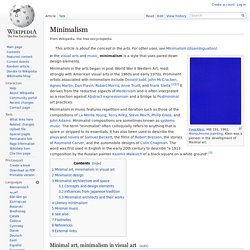
§Minimal art, minimalism in visual art[edit] In France between 1947 and 1948,[12] Yves Klein conceived his Monotone Symphony (1949, formally The Monotone-Silence Symphony) that consisted of a single 20-minute sustained chord followed by a 20-minute silence[13][14] – a precedent to both La Monte Young's drone music and John Cage's 4′33″. Although Klein had painted monochromes as early as 1949, and held the first private exhibition of this work in 1950, his first public showing was the publication of the Artist's book Yves: Peintures in November 1954.[15][16] In contrast to the previous decade's more subjective Abstract Expressionists, with the exceptions of Barnett Newman and Ad Reinhardt; minimalists were also influenced by composers John Cage and LaMonte Young, poet William Carlos Williams, and the landscape architect Frederick Law Olmsted.
§Minimalist design[edit] Idea of Progress. In intellectual history, the Idea of Progress is the idea that advances in technology, science, and social organization can produce an improvement in the human condition.
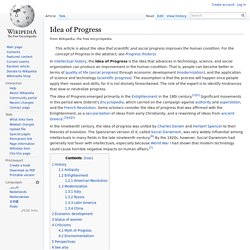
That is, people can become better in terms of quality of life (social progress) through economic development (modernization), and the application of science and technology (scientific progress). The assumption is that the process will happen once people apply their reason and skills, for it is not divinely foreordained. The role of the expert is to identify hindrances that slow or neutralize progress. Banksy: The $20 Million Graffiti Artist Who Doesn't Want His Art To Be Worth Anything. Increase the Value and Prices of Your Artwork - For Artists. << Back to Articles for Artists I bet you don't know you can take the finished artwork that's sitting around your studio and increase its value right now, do you?
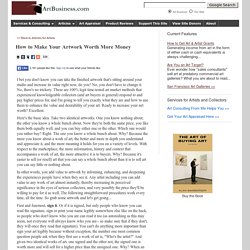
No, you don't have to change it. No, there's no trickery. These are 100% legit time-tested art market methods that experienced knowledgeable collectors (and art buyers in general) respond to and pay higher prices for, and I'm going to tell you exactly what they are and how to use them to enhance the value and desirability of your art. Ready to increase your net worth? Here's the basic idea. In other words, you add value to artwork by informing, enhancing, and deepening the experiences people have when they see it. First and foremost, sign it. You can sign your artwork on the back, on the edge, on the top, embedded within the composition, wherever. Title it. Date it. Number it. Explain it. Place it in a larger context.
Document it. Keeping good records of your art and art career is a good idea no matter how you look at it. Value Added: Artists’ Perspectives on the Meaning of Worth. Artist as Social Entrepreneur. Social entrepreneurs are individuals with innovative solutions to society’s most pressing social problems.
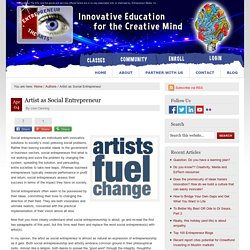
Rather than leaving societal needs to the government or business sectors, social entrepreneurs find what is not working and solve the problem by changing the system, spreading the solution, and persuading entire societies to take new leaps. Whereas business entrepreneurs typically measure performance in profit and return, social entrepreneurs assess their success in terms of the impact they have on society. Social entrepreneurs often seem to be possessed by their ideas, committing their lives to changing the direction of their field. They are both visionaries and ultimate realists, concerned with the practical implementation of their vision above all else. Artists as Social Entrepreneurs – 3 Exemplary Leaders.
As defined by Ashoka, social entrepreneurs are individuals with an innovative solution to a pressing social problem.

They are ambitious and persistent in tackling the issues they target and in offering new ideas for wide-scale social change. I gave a keynote at the SoCap13 conference titled "The Surprise Social Entrepreneur. " My talk explores the five defining characteristics of the social entrepreneur as set out by the late Greg Dees, who helped define the field of social entrepreneurship as a professor at Duke University: I then look at the case of a single entrepreneur, ticking off, point by point, how this person and the organization he started fully meet the five criteria. He is James Houghton, the founder of the 22-year-old Signature Theatre Company in New York City.
Art Activism. e10.1 Book Review - Art and Social Movements: Cultural Politics in Mexico and Aztlán. Nicholas Crane | Ohio State University McCaughan, Edward J.
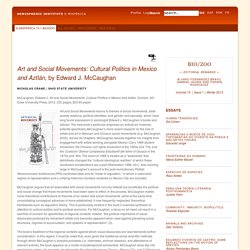
Art and Social Movements: Cultural Politics in Mexico and Aztlán. Durham, NC: Duke University Press, 2012. 232 pages; $23.95 paper.